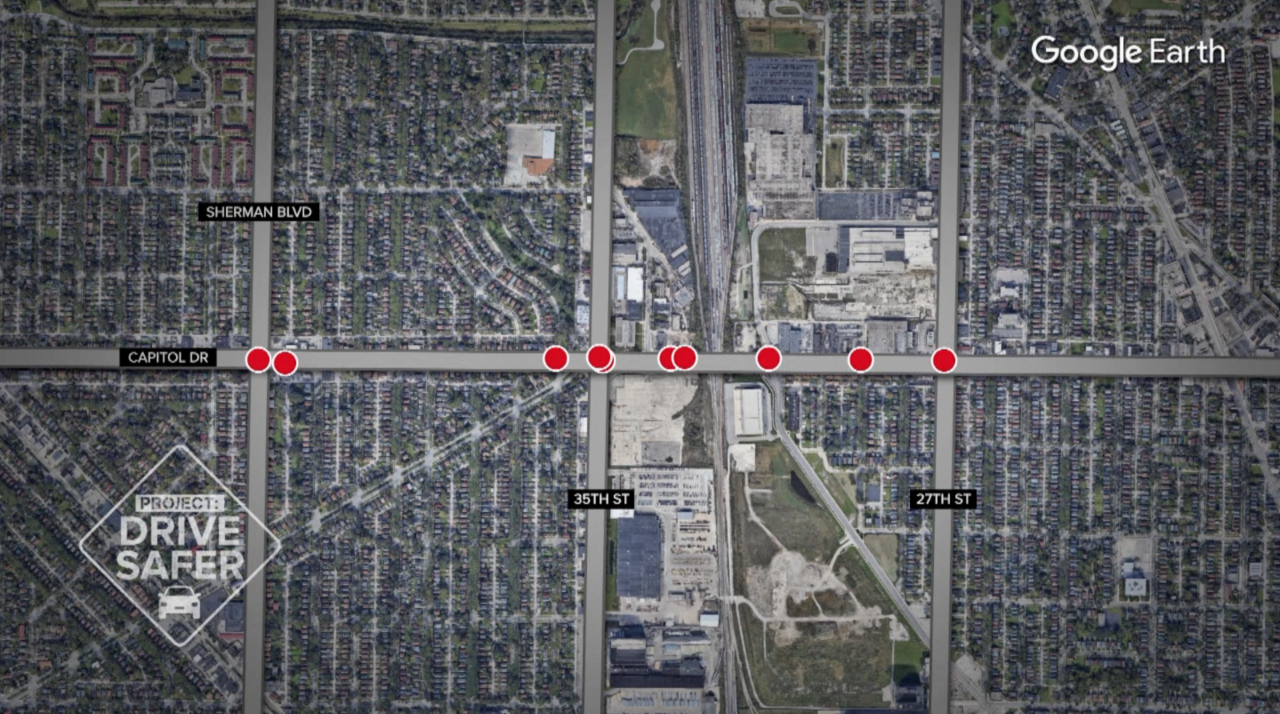MILWAUKEE — Some of the worst areas for speeding, crashes and general reckless driving in Milwaukee go through neighborhoods with a higher population of African Americans.
“It’s a freeway,” Terry Maize said. “It’s a speed zone.”
“It’s crazy,” Tyrone Cross said. “It’s reckless. Hit and run, they hit you and keep going like roadkill.”
Cross and Maize live near 35th and Capitol. They have both been there for decades and say the driving in the area has deteriorated. Since 2010, 12 people have died in car crashes within a half mile of this intersection.

“It didn’t use to be like this,” Cross said. “Milwaukee was a better place when it comes to driving. Now, it’s reckless. No regard for anybody. They don’t care.”
Since 2017, 3,349 people have died in car crashes across the state. Milwaukee County accounts for 14.8 percent of those deaths, at 498 deaths.
Because of past transportation projects, it has created division within the city that has given Milwaukee the label as the “Most Segregated City in America.” As African American men, both Cross and Maize feel government agencies like the Department of Transportation, don’t do enough for these neighborhoods to curb reckless driving.
“Come on man, that’s a no,” Maize said. “They do not. Simple as that. You’re used to not getting that assistance that we would otherwise get if we were in Whitefish Bay or Brookfield.”
“Nothing is really being done,” Cross said. “Everyone says we’ll bring change but nothing has changed. It’s changing for the worse.”
The feelings of Cross and Maize were amplified by comments like the ones a DOT spokesperson made to the I-Team in October.
“Reducing the efficiency of a roadway doesn’t make it safer necessarily,” Mike Pyritz, DOT spokesperson said. “In fact, a lot of times, it’s exactly the opposite.”
Pyritz suggested reckless drivers would drive over the pinned on curb extensions or bumpouts during an interview near 27th, Center and Fond du Lac. The intersection falls in the 53206 ZIP code, with a population over 90 percent African American.
“We’re very familiar with the fact that when the interstate system was put down, communities of color were not at the table,” Secretary Craig Thompson with the Department of Transportation said. “We need to be talking and listening. Not just talking, but listening to the communities that we’re going to be doing these things. That pertains to safety and countermeasures as well.”
As the state’s highest-ranking transportation official, Thompson says they are committed to curbing reckless driving in the City of Milwaukee.
“We do know that engineering solutions have worked in other cities,” Thompson said. “Whether that’s a road diet, curb extensions, all of that. We do need to do modeling to make sure [because] every road is different.”
Thompson sat down with the I-Team and Milwaukee Mayor Cavalier Johnson to discuss how the DOT plans to impact reckless driving equitably in the City of Milwaukee.
However, those changes won’t happen until there is proof they’ll work. While roundabouts may work in more suburban and rural areas, it likely is not feasible at an intersection like 27th Street, Center and Fond du Lac.

“We do have to look because ‘a road is a road is a road’ is not true,” Thompson said. “We talk about Capitol Drive or National or Fond du Lac, we need to look at some of these countermeasures. Whether it’s curb extensions or whether it’s a road diet, we need to do some modeling so that we’re looking at it specifically for that corridor. We’ve committed that we’re going to move forward and we’re going to do that.”
“I’m happy to hear the Secretary talk about the support of his agency for the efforts that we’re taking on the ground to curb reckless driving,” Johnson said. “They’ve been great partners and we’re looking forward to continued partnership.”
In order to make a difference, it takes funding. Mayor Johnson pointed out this partnership the city has with the DOT is imperative to move forward.
“Without additional resources from the state, that additional sort of opportunity, we’re not in a position to make the investments that we know are needed on the ground,” Johnson said. “We need the support from the State of Wisconsin in more ways than one in order to, not just carry on our services, but also make the impacts on reckless driving, especially on state arterials.”
“There is an acute problem here,” Thompson said. “Too many people are dying and we need to be a good partner with the City to do everything we can to change that and some of that is engineering, some of that is enforcement and some of that is education.”





